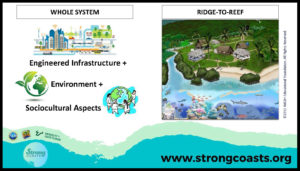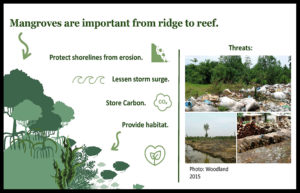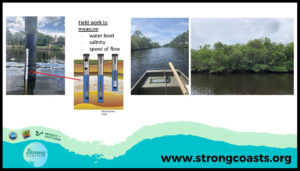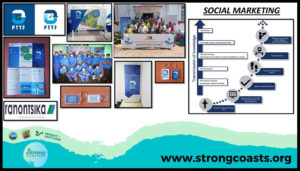By Addie Buerck (USF fellow), Allison Holevoet (UVI fellow), Heather Hopkins (project coordinator), and Megan Kramer (USF fellow)
In April 2021, Strong Coasts was invited to participate in Stewart Middle Magnet School’s (https://www.hillsboroughschools.org/stewart) virtual Earth Day celebration. Three Strong Coasts fellows, Addie Buerck (USF), Allison Holevoet (UVI), and Megan Kramer (USF), and project coordinator, Heather Hopkins, organized a presentation highlighting the fellows’ current interdisciplinary research and the importance of Strong Coasts’ systems-thinking, community-engaged approach. Read further for each participant’s reflection on her experience (in the order of presentation) and view a recording of the presentation via our YouTube Channel here: https://youtu.be/W5JsT9tM3-Q.
Heather Hopkins, NRT Strong Coasts Project Coordinator
I am keenly aware of how cultivating community-engagement and interdisciplinary thinking among young learners, and arranging encounters with professionals from different disciplines, are beneficial to growing a collaborative mindset in future generations. As youth are exposed to the innovative possibilities that stem from such work, they will be motivated to explore complex problems through a wider lens with different perspectives, instead of choosing a narrow view of the world. So, I was thrilled when Stewart Middle Magnet School in Tampa, FL, gave our group the opportunity to present to young learners.
We decided to prepare our own slides with individual talks, allowing each fellow to utilize science communication and presentation skills learned through Strong Coasts activities or other resources. I kicked off the presentation with a brief overview of our program that demonstrated how our fellows examine engineered infrastructure, environment, and sociocultural aspects, as a whole system instead of treating them as if they do not interact with each other.

IMAGE 1: Slide from Heather Hopkins’ presentation.
I made sure to provide a lesson on how this, along with community-engagement, leads to a more comprehensive understanding of global environmental problems and to more innovative solutions that support sustainability along the ridge-to-reef.
The fellows followed and did an awesome job presenting in their own voice! The flow of their presentations kept the middle schoolers engaged and their creativity shined in every slide. Thank you, fellows, for your fun and informative contribution, and thank you Stewart Middle Magnet School for the privilege of sharing with your students.
Allison Holevoet, UVI Marine and Environmental Science Masters student
Located on a ridge–to–reef gradient, mangroves are important coastal ecosystems that provide many ecosystem services including, carbon storage, habitat for juvenile fish, and coastal protection from erosion and storms.

IMAGE 2: Slide from Allison Holevolt’s presentation.
Although considered resilient systems able to bounce back after disturbances, global stressors such as deforestation (Atwood et al., 2017), climate change, and sea-level rise, threaten the viability of mangroves and the provision of ecosystem services. Localized stressors such as coastal development and removal in the Caribbean can be just as harmful and thwart natural regeneration. Although mangrove restoration efforts have occurred in the U.S. Virgin Islands, these efforts have been few and often restoration methods, techniques, and outcomes are more locally known and missing in peer-reviewed literature. Therefore, my thesis will test grow-out techniques with Rhizophora mangle to maximize propagule growth in a nursery setting in the U.S. Virgin Island of St. Thomas.
With global climate change and climate resistance in mind, restoring coastal areas are imperative now more than ever. Identifying grow-out practices for the territory can provide guidance for communities and stakeholders in future restoration projects, highlighting efficient and effective restoration techniques while reducing time, money, and effort on unsuccessful practices. Engaging with coastal communities, presenting on such topics, especially with youth, can integrate localized knowledge into systems thinking and inspire the next generation of coastal stewards as we work together towards solving the resilience problems of tomorrow.
Megan Kramer, USF Civil and Environmental Engineering PhD student
A favorite high school teacher of mine, Mr. Wienski (North Thurston High School), encouraged me to pursue engineering, claiming it was a versatile field which I could apply to whatever topic I find interesting. At the time, I had a very narrow vision of what a future in Science Technology Engineering and Mathematics would look like, but because of his advice I took a leap and pursued a degree in a field I had not considered. I found that my choice to study engineering has literally opened a world of opportunities, including moving cross-country from Washington to Florida to explore the state’s beautiful coastal mangrove ecosystems.

IMAGE 3: Slide from Megan Kramer’s presentation.
For this reason, I was so excited to discuss my research on Earth Day with the students at Stewart Middle School and provide exposure on the diverse paths that lie in a future in STEM. I believe it is so valuable to show that science can look like so many different things. In my presentation, I got to share about my current hydrodynamic modeling project and how it is inherently linked to the environment and local community. The objective is to evaluate the effects of a restoration project on water movement for a waterway located in Charlotte Harbor, Florida. This entails numerical simulations in addition to trips to the field to gather data including water levels, salinity, and flow. While the physical components of the system are important for numerical simulations, to better understand the system, biological and social components must also be considered. It was such a pleasure to spend Earth Day discussing some of the science behind decisions that impact people and our precious planet.
Adaline Buerck, USF Civil and Environmental Engineering PhD student
As a young student in school my favorite days were when we had different presenters come in and talk about what they do. It opened my eyes to different careers that I had not thought about, and I was able to see the passion they had for what they did. I think about the impact that those presentations had on me and hope that by presenting I can encourage that same enthusiasm in youth of today. I also hope that through showing how I work at the intersection of engineering, social marketing, and public health opens students’ eyes to the immense possibilities for careers and the overlap between disciplines.
My research is based in the coastal city of Tamatave, Madagascar where centralized piped water is not always affordable or reliable, creating a demand for supplemental decentralized self-supply water systems, a common occurrence in low-income countries. In Tamatave, these supplemental systems frequently take the form of a manually driven well point and locally manufactured pitcher pump that serve a household or a small group of households. These pitcher pumps are traditionally built with lead (Pb) components sourced mainly from old car batteries. Unfortunately, the Pb components contaminate the water and pose a range of health risks. This research presents a cross disciplinary approach that engages local stakeholders to understand chemical interactions, market forces, and local culture to design a safer and more improved product and messaging to support behavioral change to prevent further lead exposure from drinking water and protect the health of the local communities. To develop a sustainable solution to protecting health, my team of engineers, social scientists, and community organizations developed a social marketing campaign targeting pitcher pump technicians who manufacture, install, and repair the pumps.

IMAGE 4: Slide from Adaline Buerck’s presentation.
We couple our social marketing campaign with an intervention to replace leaded pump components with non-leaded components, and with blood lead level testing of children in the community. Taken together, we hope that this more holistic understanding of the community and impact of lead exposure better demonstrates in Tamatave that improved global health associated with chemical pollution is possible by reducing exposure to lead (Pb) contaminated water.
NRT Strong Coasts’ Stewart Middle School Earth Day Presentation RECORDING:
About the Authors:
Heather is the NRT Strong Coasts Project Coordinator and is a dedicated natural resource management specialist with a passion for cultivating balanced interactions among people and nature to ensure a more sustainable future. She has a background in managing environmental education programs and exploring cutting-edge topics in science and technology alongside diverse and multidisciplinary stakeholders. Heather received a B.S. in Biology (Systematics & Ecology) and a B.A in Environmental Studies from the University of Kansas, and a Graduate Certificate in Natural Resource Management through Virginia Tech’s Center for Leadership in Global Sustainability (CLiGS). Her research focused on systems-thinking approaches to conservation and preserving biodiversity, innovative solutions for anthropogenic caused human-wildlife conflicts, and effective environmental communication. Heather’s current interest is exploring the connections between wildlife, biodiversity, and FEWS sustainability.
Allison is a first-year graduate student pursuing a Master’s in Marine and Environmental Science at the University of the Virgin Islands, St. Thomas. After graduating with undergraduate research in coral reef ecology and a B.S. in Marine Biology, Allison followed her scientific curiosities to Alaska where she spent three years living and working aboard commercial fishing vessels collecting data for in-season fisheries management. Her current research interests include coral reef fisheries, aquaculture, and mangrove restoration with a focus on holistic approaches in sustainability to enhance the standards of stewardship for our coastal areas.
Megan is a first-year graduate student pursuing a Ph.D. in Environmental Engineering at the University of South Florida. She received her BS in Civil Engineering from Gonzaga University, after which she spent nearly two years as a Peace Corps Volunteer in Tanzania. Her service was spent as a secondary school mathematics teacher, though she also supported the school as co-manager for a health/hygiene dormitory improvement project and coordinated interactive HIV/AIDS youth education projects. Megan’s research interests include coastal sustainability, reef restoration, and international development.
Addie is a PhD student in USF’s environmental engineering department. She is currently looking at lead mitigation in pitcher pumps in coastal Madagascar. This research is taking an interdisciplinary approach, looking at the engineering aspects around the pump and also the social aspects. To achieve this she is also working on a Social Marketing Certificate from USF and working closely with scholars in Social Marketing. She received her master’s in civil engineering from Saint Louis University in 2018. Her master’s research looked at arsenic (III & V) removal through iron-oxide coated ceramic filters. Her undergraduate degree was also from Saint Louis University (2016) in civil engineering with a minor in business administration.
STRONG COASTS is supported by a National Science Foundation Collaborative Research Traineeship (NRT) award (#1735320) led by the University of South Florida (USF) and the University of the Virgin Islands (UVI) to develop a community-engaged training and research program in systems thinking to better manage complex and interconnected food, energy, and water systems in coastal locations. The views expressed here do not reflect the views of the National Science Foundation.

Comments are closed.